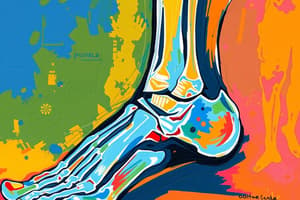Podcast
Questions and Answers
What is the most common inherited progressive peripheral neuropathy?
What is the most common inherited progressive peripheral neuropathy?
- Charcot-Marie-Tooth Disease (correct)
- Lumbar Plexopathy
- Diabetic Neuropathy
- Hyperkinetic Movement Disorder
What is the primary characteristic of Type I CMT?
What is the primary characteristic of Type I CMT?
- Axonal death caused by Wallerian degeneration
- Abnormal peripheral myelin protein
- Demyelinating condition that slows nerve conduction velocity (correct)
- Direct axonal death caused by Wallerian degeneration
What is the primary cause of muscle weakness in CMT?
What is the primary cause of muscle weakness in CMT?
- Axonal death caused by Wallerian degeneration
- Demyelination of nerve fibers
- Muscle atrophy
- Abnormal peripheral myelin protein (correct)
What is the typical age of onset for Type I CMT?
What is the typical age of onset for Type I CMT?
What is the primary treatment approach for CMT?
What is the primary treatment approach for CMT?
What is the primary goal of medical management for type 1 DM in the context of diabetic polyneuropathy?
What is the primary goal of medical management for type 1 DM in the context of diabetic polyneuropathy?
Which of the following is NOT a potential cause of lumbosacral plexopathy?
Which of the following is NOT a potential cause of lumbosacral plexopathy?
What is a common symptom of lumbosacral plexopathy?
What is a common symptom of lumbosacral plexopathy?
What type of medications are commonly prescribed for neuropathic pain in diabetic polyneuropathy?
What type of medications are commonly prescribed for neuropathic pain in diabetic polyneuropathy?
What is the primary goal of multidisciplinary team management in diabetic polyneuropathy?
What is the primary goal of multidisciplinary team management in diabetic polyneuropathy?
What is the primary symptom of patients with pregnancy-related postoperative plexopathy?
What is the primary symptom of patients with pregnancy-related postoperative plexopathy?
What is the best diagnostic test for evaluating the lumbar-sacral plexus?
What is the best diagnostic test for evaluating the lumbar-sacral plexus?
Which type of plexopathy often presents without pain, only with weakness and sensory changes?
Which type of plexopathy often presents without pain, only with weakness and sensory changes?
What is the characteristic of Hyperkinetic Movement Disorders (HMDs)?
What is the characteristic of Hyperkinetic Movement Disorders (HMDs)?
What is a potential complication of lumbar plexopathy?
What is a potential complication of lumbar plexopathy?
What is the estimated percentage of patients with diabetes that are affected by diabetic neuropathy?
What is the estimated percentage of patients with diabetes that are affected by diabetic neuropathy?
What is a major risk factor for diabetic neuropathy?
What is a major risk factor for diabetic neuropathy?
What is the most common type of diabetic neuropathy?
What is the most common type of diabetic neuropathy?
What is a possible complication of diabetic neuropathy?
What is a possible complication of diabetic neuropathy?
What is the underlying cause of diabetic neuropathy?
What is the underlying cause of diabetic neuropathy?
What is the characteristic of Myoclonus movements?
What is the characteristic of Myoclonus movements?
What is the term for Hyperkinetic movement disorders classified according to body distribution?
What is the term for Hyperkinetic movement disorders classified according to body distribution?
How is Dystonia classified based on the body parts affected?
How is Dystonia classified based on the body parts affected?
What are the five major types of Hyperkinetic Movement Disorders?
What are the five major types of Hyperkinetic Movement Disorders?
What is Chorea characterized by?
What is Chorea characterized by?
What percentage of diabetic neuropathy cases are asymmetrical or focal syndromes?
What percentage of diabetic neuropathy cases are asymmetrical or focal syndromes?
What is a common symptom of diabetic neuropathy in the hands or feet?
What is a common symptom of diabetic neuropathy in the hands or feet?
What is the purpose of testing gross light touch and pinprick sensation in diabetic neuropathy diagnosis?
What is the purpose of testing gross light touch and pinprick sensation in diabetic neuropathy diagnosis?
What is the classification of diabetic neuropathy that affects the autonomic nervous system?
What is the classification of diabetic neuropathy that affects the autonomic nervous system?
What is the staging of diabetic neuropathy characterized by severe symptomatic polyneuropathy and inability to heel walk?
What is the staging of diabetic neuropathy characterized by severe symptomatic polyneuropathy and inability to heel walk?
What is the primary characteristic of tics?
What is the primary characteristic of tics?
What is dystonia characterized by?
What is dystonia characterized by?
What is an important aspect of diagnosing movement disorders?
What is an important aspect of diagnosing movement disorders?
What is a goal of management for movement disorders?
What is a goal of management for movement disorders?
What is a characteristic of tremors?
What is a characteristic of tremors?
What is important to consider when diagnosing movement disorders?
What is important to consider when diagnosing movement disorders?
What is another term for hyperkinetic movement disorder?
What is another term for hyperkinetic movement disorder?
What is a goal of management for movement disorders related to gait?
What is a goal of management for movement disorders related to gait?
What is a feature of tics?
What is a feature of tics?
What is a goal of management for movement disorders related to respiratory function?
What is a goal of management for movement disorders related to respiratory function?
Flashcards are hidden until you start studying




